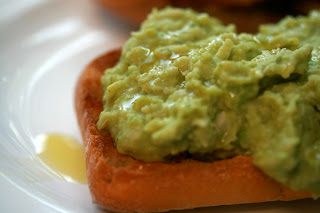One of the early declarations of love I heard from Mr A&N was that he was totally, madly, utterly enamored with broad beans. The pinnacle of the broad bean world could be found in his grandparents garden; according to him, they grew the most wonderful beans known to man and his adult summertimes were spent with sighs of recollection for those beans he could no longer have. At that stage I wasn't able to tell a broad bean from a carburetor, so I needed Mr A&N to introduce me to this magical bean.
There is very little that he and I disagree on, and those few things disappear almost completely once we move into the food arena, but none of my attempts to fall in love with the broad bean brought me even slightly close to enjoying them. Also known as the fava bean in North America, I found the broad bean a bit too much like one of my only hated food stuffs, the lima bean. It was powdery and slightly bitter, and when simply boiled and dressed with a bit of butter or oil, its powdery bitterness was intensified to a degree that I couldn't face a mouthful of them. As much as I enjoyed shelling the large pods with their wonderfully velvety insides, that's as far as I've been willing to get to broad beans for a while.
And now with our weekly vegetable box delivery, broad beans have been brought straight to our door and are harder for me to turn my back on. I decided that rather than just demanding Mr A&N eat them all (hardly a hardship for him) I should again try to embrace them and maybe make them in a different way. Broad bean hummus seemed to hold out the hope of doing away with the powdery texture I didn't enjoy and forcing some different flavors into the mix. Just like chickpea hummus, I threw in garlic and some lemon, and went a bit luxury with extra butter and herbs. Served with good crusty bread, I actually did enjoy it and ate my whole slice. I might not be returning to simple, boiled broad beans any time soon, but at least now I stand a chance of enjoying both the shelling of the pods and what follows from that.
Broad Bean Hummus
enough for 1 1/12 dozen small tapas bread triangles, or 2-3 large, generous toppings for good crusty bread
- 1 kg broad bean (fava bean) pods
- bunch of fresh oregano (optional)
- 2 soup spoons of cooking liquid
- 1 large/2 medium cloves of garlic
- juice of 1 1/2 - 2 lemons
- knob of butter (about 10-15 g)
- olive oil (about 1/4 C)
- salt and pepper to taste
- Boil water in a medium-sized pot and when boiling, place the oregano in with it.
- Shell the broad beans and when all are shelled, place them in the pot of boiling water.
- Boil the beans and oregano for 5-7 minutes or until the beans are nicely softened.
- Drain the beans, reserving a couple of soup spoons of the cooking liquid and a few springs of oregano.
- Place the beans, reserved liquid, and oregano in a blender. Add in the garlic, lemon juice, and butter, and turn the blender on.
- Slowly add the olive oil, letting the mixture blend itself for 60 seconds or so once the oil is added. If it looks to dry (or if it's so dry it's not even blending), add a bit more oil (or water if you're being healthy) and continue blending. Otherwise, test the mixture and adjust for taste. Add more oil if it still doesn't taste creamy enough, and add salt and pepper.
- Serve over bread, either as a tapas-style starter or as a bruschetta-style accompaniment to a main course.









